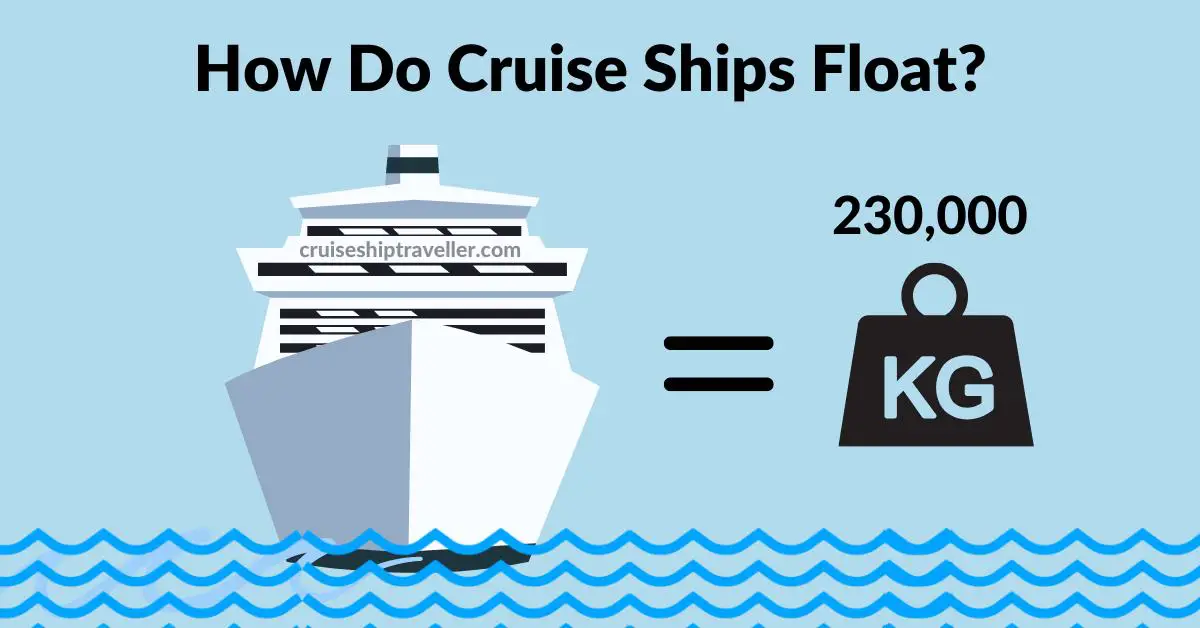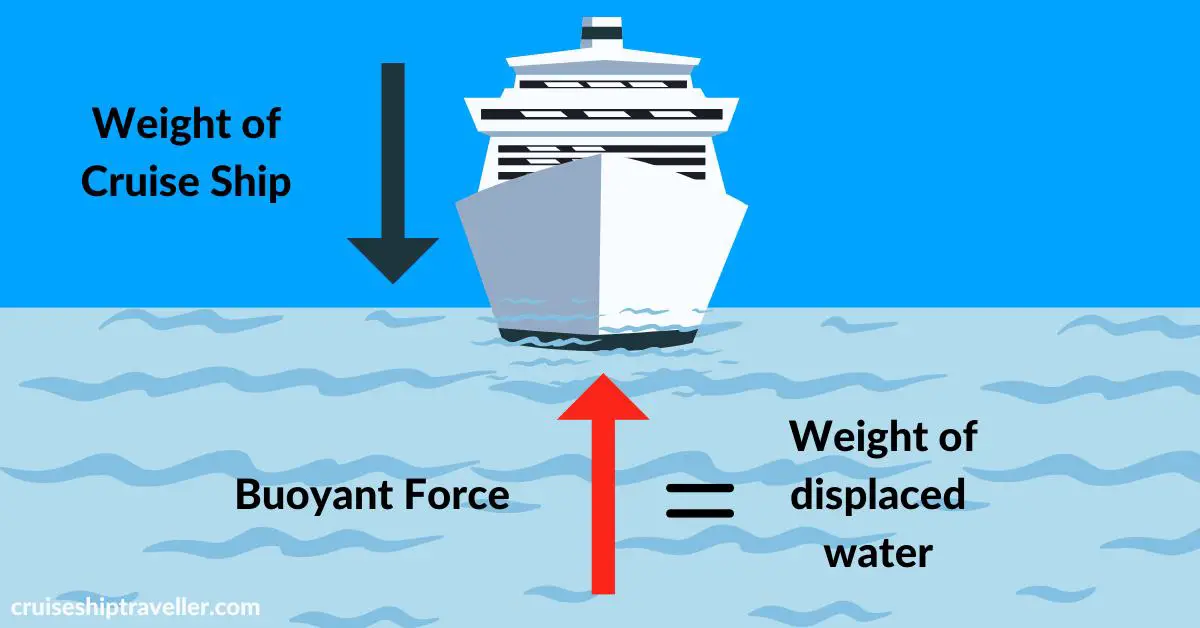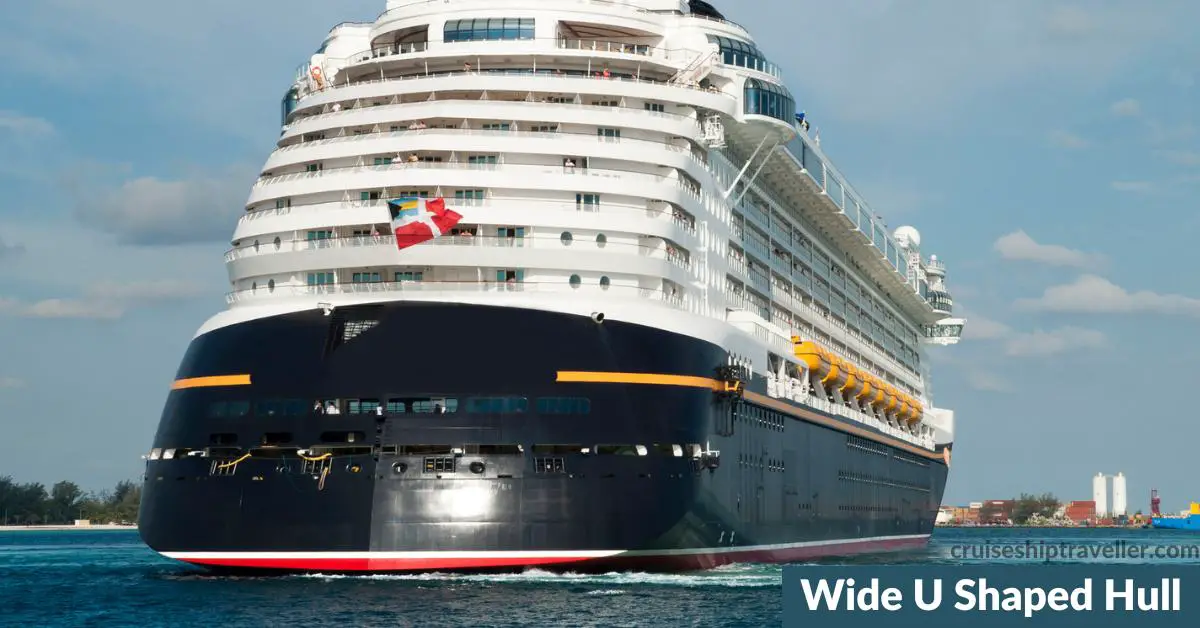Have you ever looked at the size of a cruise ship, especially the modern-day mega-ships in particular, and wondered how they float?
This is even before knowing how much some of these vessels weigh, with no less than 5 of the largest Royal Caribbean cruise ships coming in with a gross tonnage of over 200,000 and the largest Wonder of the Seas, a staggering 236,857 gross tonnes.
It’s a wonder how they stay afloat.

That’s even before all the guests’ weight and luggage is put onboard.
Not to mention the weight of hundreds of crew members who live onboard the cruise ship.
In this post, I aim to explain as clearly and simply as possible how a cruise ship floats no matter how large they are built and then go into a little more depth, illustrating each of the key factors more clearly.
How Does a Cruise Ships Float?
Although made of steel, much of a cruise ship hull is hollow, less dense than the amount of water it displaces. The ship’s weight is spread over a large volume, including a wide hull and overall surface area, which spread over a wider area of water and offers more of an upward force, keeping it afloat. This is known as a buoyant force or buoyancy.
Let’s look at each aspect in more detail.
Whether an object floats or sinks comes down to the laws of physics, in this instance, its buoyancy.
So what is buoyancy?
Buoyancy is the ability of an object to float on a fluid.
To expand further.
Buoyancy is an upward force exerted by fluid, in this case, water, that opposes the weight of an object partially or wholly immersed, ie, a cruise ship.
In simple terms, if a 100,000 gross tonne cruise ship can displace an equal weight in water, in this case, 100,000 gross tonnes of water, it will be buoyed up by force created, and the pressure from the seawater will force the cruise ship to stay afloat.
Various factors come into play to ensure that a cruise displaces an equivalent amount of water to its own weight.
Archimedes Principle
Buoyancy is an ancient law of physics known as the Archimedes’ principle, which was discovered around 246 BC and named after the Greek Mathematician and inventor who discovered it.
The Archimedes Principle states that an object immersed or partially immersed in a fluid will float when the weight of the water it displaces is equal to the object’s weight.
It’s the water that is displaced, pushed aside by the object, that is trying to push its way back to its original position that creates the upward force that meets the downward force of the object, that when equal, meets a floating point.
How buoyant an object is depends on two main factors:
- Density
- Displacement – the amount of water the object displaces
Various other factors also come into play which we have broken down and expanded on below to give you a clearer understanding of each one’s contribution to keeping a cruise ship afloat.
Density
A stone is a dense object.
It’s a solid compact object all the way through.
Therefore no matter how large or small it is, from a large rock to a tiny pebble, because of their density, they will all sink.
This is because of its density, the stone weighs more than an equal volume of water. Therefore the stone sinks.
Compare this to a stick or even the whole trunk of a tree. Because wood density is less than water, the stick or tree trunk will float. The weight of the wood to an equal amount of water is less.
Even though cruise ships weigh thousands of tonnes, because they are not dense objects, they will float if they displace enough water equal to their weight, they will float.
Even though cruise ships can weigh thousands of tonnes, many hollow areas are filled with air. It’s not like the ship is a solid mass of steel.
These hollow air-filled spaces reduce the average density of the cruise ship’s volume.
If the average density of the cruise ship is ever more than the weight of the water, it displaces, it will sink.
This was the case with the Titanic, which hit an iceberg damaging the ship and allowing water to enter, increasing the ship’s density. Once the ship’s density is more than the density of water displaced by the ship, the ship sinks.
However, the cruise ships’ designers still need to ensure they not only float but that they float upright and don’t tip over, even in rough seas.
Two Forces Meeting
In understanding buoyancy further, it is worth explaining the role of forces.
When a cruise ship is launched into the water, two forces come into play and act on it to keep it afloat.
Firstly you have the weight of the cruise ship.
Once it’s in the water, the weight of the cruise ship meets what is known as the “upthrust” or “buoyant force”. This is the upward force of the fluid, in this case, the seawater.
If there were no upthrust, nothing would float.
When the two forces meet, it’s here that an object will float or sink.
When the weight of an object is more than the upthrust, it will sink. If the weight is less, it will float.
This is known as the Archimedes Principle, as outlined above. It’s the action of an upward force on an immersed object (cruise ship) in fluid (the sea). The force is equal to the weight of the displaced fluid by the object.

Weight and Volume
Although cruise ships can weigh thousands of tonnes, this weight is spread over a vast volume.
To see how this is relevant, let’s look at an example.
If you took an apple that weighs 100g and a nickel coin that weighs 5g.
Even though the apple weighs 20 times more than the nickel if you place them into a container of water, which one will float?
The apple will float, and the nickel will sink to the bottom.
This is because the apple’s weight is spread over a much larger volume in relation to its weight. Its density is less than the nickel coin.
This is similar to a cruise ship.
The ship’s enormous weight is spread over an equally colossal volume (and it’s not solid like a nickel).
Surface Area
Buoyancy is the upward force pushing up on objects that come into contact with it.
The larger the object’s surface area, in this case, the hull of a large cruise ship, the more weight it can support.
The large surface area of the cruise ship means there’s a very wide area of water to push up against the surface and, therefore, more force to keep the cruise ship afloat.
Displacement
A cruise ship floats because although it is made of dense steel its shape and design enable it to enclose large volumes of air, the overall cruise ship’s density is less than the water it displaces. Therefore allowing it to float.
By displacement, we mean that some of the water must move for the cruise ship to sit in the water. The water and the ship cannot occupy the same space. The cruise ship pushes water to the side. This is displacement.
To understand this concept, fill a glass of water right to the top. If you place an object into the water, some water will be displaced and fall over the sides of the glass. The same thing happens in the sea, the water is pushed to either side of the ship, it’s displaced.
A cruise ship, although made of steel can be lighter in weight than the seawater it displaces because it is not solid steel.
The hull of a cruise ship is hollow, therefore primarily full of air and much lighter than the equivalent amount of water it displaces.
If the hull were damaged and water was to get in and fill the space occupied by the air, the density of the hull and the cruise ship would increase in relation to the water it was displacing and the ship would likely tip over, and eventually, the cruise ship would sink.
Shape of Hull
The larger the cruise ships have become, the more water they need to displace for them to be able to float.
Therefore cruise ships are designed with wide U-shaped hulls, which displace more significant amounts of water which is moved out of the way on either side of the ship, thus creating a greater force that keeps the ship afloat.

The more water that is displaced, the more buoyancy force is created and the more weight it can support as the water tries to return to its original location. Remember, the ship has to displace an equal weight in water to the weight of the ship itself to float.
The hulls of a cruise ship are often referred to as displacement hulls because they are designed to displace (move) as much water as possible to the sides. Their rounded edges help to dissipate the drag enabling smoother sailing.
You can see this more clearly when you look at the bottom of a cruise ship.
This is in contrast to many ships with V-shaped hulls that almost bounce on the waves compared to U-shaped cruise ships that move in a much flatter stable motion.
However, the disadvantage is that they move slower than their V-shaped counterparts.
Weight Distribution
Weight distribution is vital in ensuring the cruise ship has a low center of gravity.
The lower part of the ship is much heavier than the higher decks.
The lower decks are weighed down with:
- Machinery in engine rooms
- Fuel tanks
- Freshwater water tanks
- Luggage
- Food Storage
There can be as much as 2000 tonnes of fuel and 3000 tonnes of freshwater on some of the largest cruise ships.
The upper decks are much lighter in comparison, there’s much more open space that is full of air.
There are some heavy areas on the cruise ship, such as the swimming pools, which, when full, can weigh over 200 to 250 tonnes, but if, for any reason, the center of gravity needs to be adjusted, they can be emptied.
How Deep Does The Water Have To Be For A Cruise Ship To Float?
The water depth needed for a cruise ship to float has to be at least a couple of feet or a meter deeper than the cruise ship’s draft, which could be 25ft to 30ft (7.6m to 9.1m ) for a mega cruise ship.
If a cruise ship is coming into a port with mixed water levels, a maritime pilot or harbor pilot, as otherwise known, will be sent out to guide the cruise ship through the deepest water levels to dock.
The maritime pilots will be experts in the depths and conditions of the dock’s waters, helping the cruise ship to avoid any higher surfaces of rock or mud, etc.
Video – Why Do Big Ships Float?
For an overall explanation of all aspects that keep a cruise ship aflot, check out this video. It has some good visual examples to illustrate some of the key points I’ve highlighted above.
Frequently Asked Questions
Is it Easier for a Ship to Float in Seawater?
If you have ever noticed your body is more buoyant in seawater, you may have wondered if it’s the same for cruise ships.
Seawater is denser than freshwater, increasing the buoyancy of any objects floating on this.
Freshwater has a density of 1000kg/m^3, whereas seawater has a density of around 1030kg/m^3, although this can vary.
An extreme example would be the Dead Sea which has a density of 1240kg/m^3, where your whole body will float without trying.
What Is The Largest Cruise Ship Afloat?
The Royal Caribbean Wonder of the Seas is the largest cruise ship afloat, with a gross tonnage of 236,857 and 362.04 m 1,187.8 ft in length.
Royal Caribbean Harmony of the Seas is the longest at 362.12 m or 1,188.1 ft and slightly lower gross tonnage of 226,963, making it the 3rd largest by that metric.
How Do Cruise Ships Not Sink?
While a cruise ship’s weight equals the water it displaces, it will not sink.
Once the weight of the ship is more than the weight of the water it displaces, it will start to sink, but as it does so, it will displace more water.
If the cruise ship can maintain airtight spaces on the cruise ship via the ballast tanks and utilize inbuilt bulkheads, it can prevent sinking if it can keep its weight at any point equal to the amount of water it is displacing. The more airspaces and less dense the cruise ship can be made, the less chance it has of sinking.
Conclusion
As you can see, there are several design factors that come into play in allowing even the largest of cruise ships. Fundamentally it comes down to physics and creating a ship that is equal in weight to the water it displaces.


